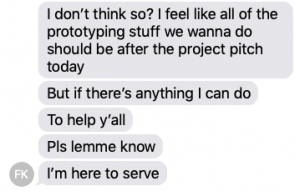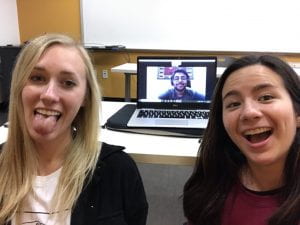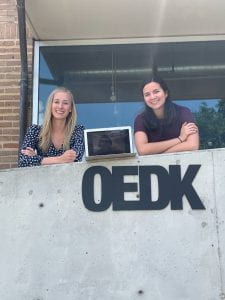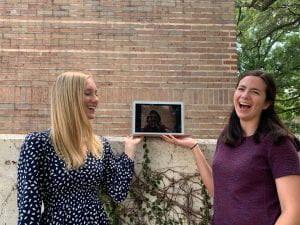I was not allowed to watch TV until I was in first grade. Yes, yes, how did I survive, that’s so sad, I didn’t have a childhood, etc. I’ve heard it all. But looking back, I’m grateful–I don’t find myself addicted to my screen the way that some of my friends are, and TV doesn’t have the same appeal for me as it does for everyone else.
However, when COVID-19 struck, I had to adapt to centering my life around screens. All social interactions suddenly became virtual–in order to talk to my friends, I had to pull out my phone. And although I’m still not a big fan of Facetime or Zoom, I’ve learned to value their unparalleled ability to bring people together in difficult times.
When I first found out that I would be in the only hybrid team in the internship, I was nervous. How would prototyping work? How would we productively brainstorm together? How could we ensure that everyone was included? The first week took some adjusting: finding a conference room with a working webcam, only having full team discussions in the morning, and Zooming in Fadeel for standup meetings. After spending so much time interacting only virtually, it was tough to be stuck in limbo between the COVID-19 world and normalcy.
I am constantly inspired by Fadeel’s ability to handle this dual environment. Right away, he suggested ways that he could contribute, including filling in research, keeping detailed documentation, and even remote prototyping if needed. I’ve attached a series of texts he sent after one of our daily text briefings (in which we’d catch him up on what was accomplished during the day and our suggestions for things he could work on while we slept), which pretty much sums up his eagerness to help us in the best way possible.
In the end, I think our team adapted marvelously to the hybrid situation. We took several hybrid team pictures, some of which I’ve attached in earlier blogs, and some of which I’ll attach below.
We also had hybrid team meetings every morning, staking a permanent claim to one of the OEDK conference rooms. All of the other interns loved hearing Fadeel’s voice boom down the hallways on the conference room speaker, or waving to him in the background of our Zoom camera.
My favorite part was hybrid team standups. I put myself in charge of virtual integration, which meant holding up my computer and walking around the room to show Fadeel the progress that each team had made and passing around my speaker so that he could hear us clearly. I can’t explain the joy I felt whenever people would wave at my computer or carefully say hi into the speaker (except Alois, who decided to yell into the speaker in his excitement).
One of my happiest moments occurred during Dr. Taylor’s end-of-internship speech, in which she was sharing a funny story about assumptions. When she finished the story, Fadeel posted a gasping emoji on his Zoom screen, and immediately the room erupted into laughter. It felt like he was sitting right here alongside us.
Seeing the way that the interns worked together to adapt to the hybrid environment made me realize two things: one, the power of technology to bridge enormous gaps in tough times, and two, I am passionate about bridging these gaps. It all made sense: my desire to pursue global health roots in my desire to bridge gaps in global healthcare access, so of course I would get super excited about little things like serving as Fadeel’s eyes and ears here in Houston. I’ve learned so much patience and creative thinking solely from the hybrid aspect of this internship, and I’m so happy that I was placed in this hybrid team.
So in the end, although I pride myself in my ability to resist downloading Tik Tok and binge-watching Netflix, I am grateful to technology for the way it can bring people together all over the world.



